Video Recap: Hiking to Crater Lake and Hudson Mountain, near Smithers, BC
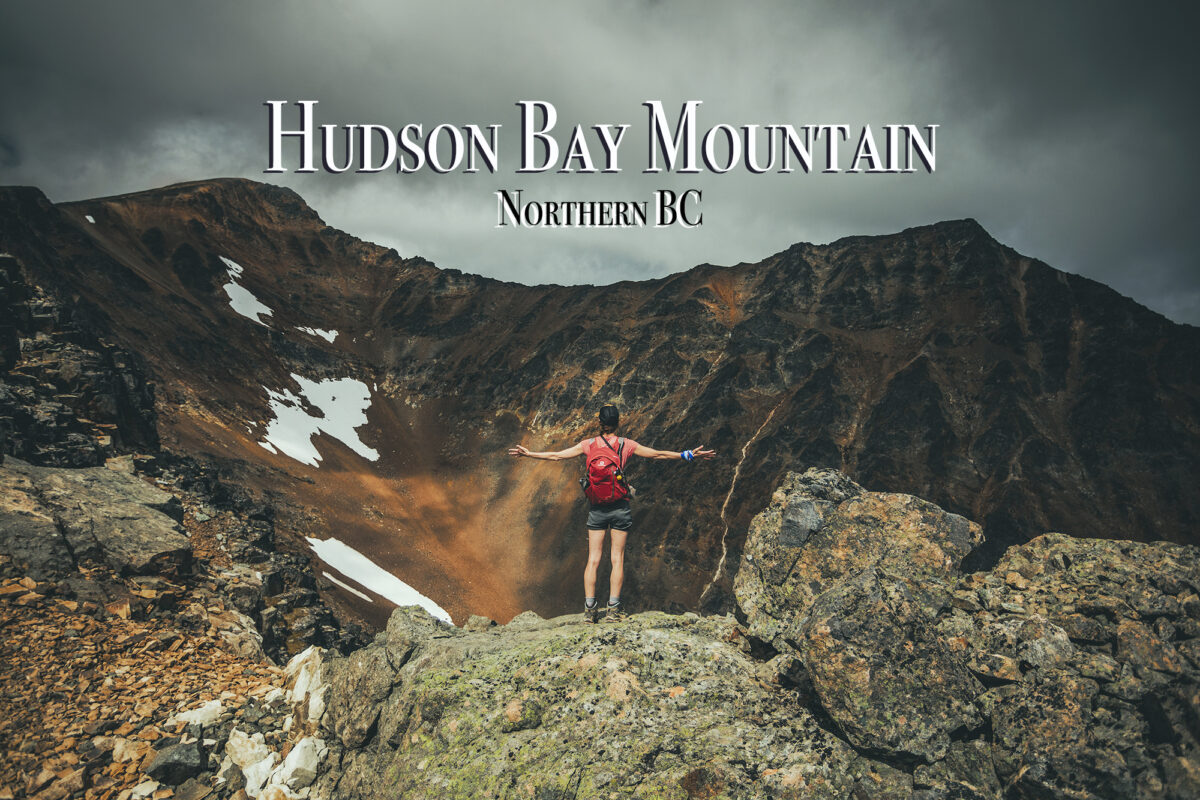
Our adventures around the world…

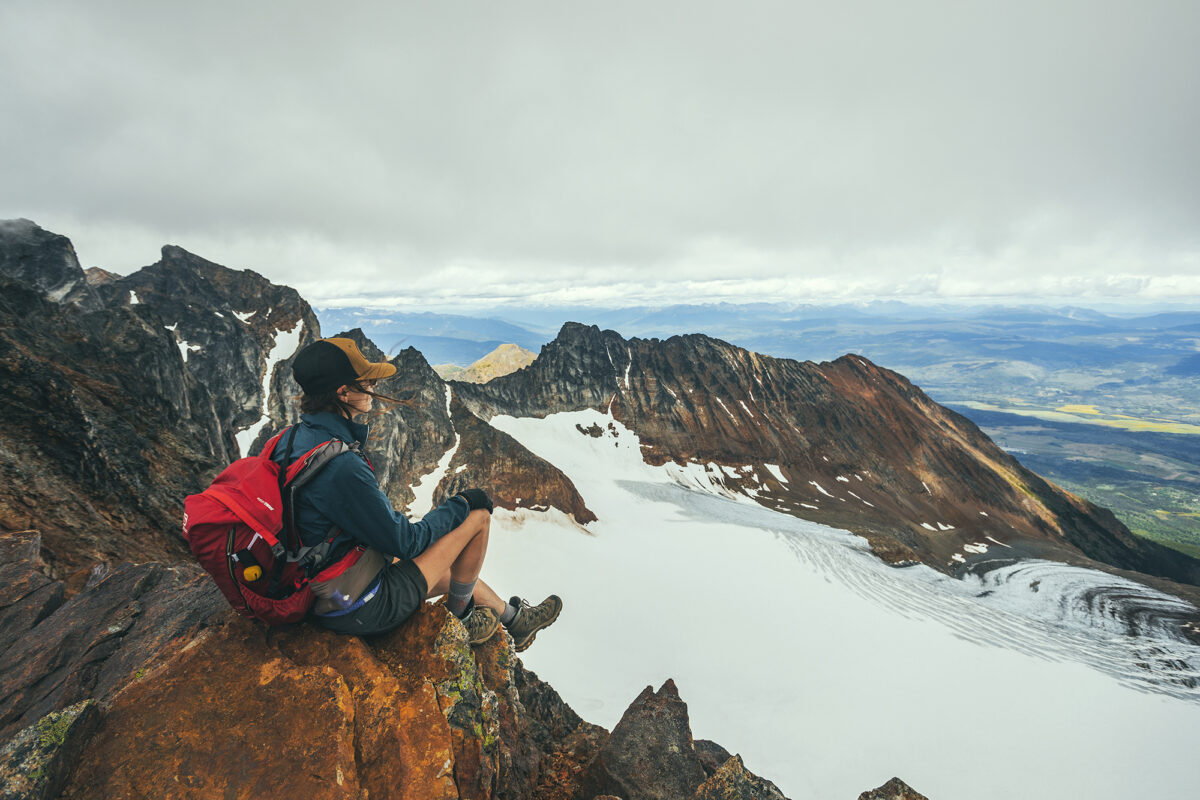
In the summer of 2021, after 2 years of working through a very challenging project, not to mention a world-wide pandemic, I was able to take 2 months off work. Yukon had been on our list of places to travel to for a bit, and with flying and travel restrictions still in place, it seemed like the right opportunity to take this trip.
I kept a journal as we drove through Western Northern BC, into the Yukon, up to Tombstone Territorial Park, back down to Kluane National Park, then down through Eastern Northern BC before returning to Vancouver. The next few posts are a transcript of that journal, complemented by the 1000s pictures we took along the way…
That summer, BC experienced a gnarly heatwave (due to a meteorological “heat dome”), followed by dramatic wildfires spreading in all areas around the lower mainland. When we left Vancouver around 10am on Aug 2nd, I was a bit worried about the wildfires in the Okanagan, and what that would look like for our itinerary. Looking at the Emergency BC App and the BC Wildfire Map, I could see that the shortest route, through the Fraser Canyon, would take us right through the main evacuation alert/order zones. Not Ideal.
So instead we took a slight detour, following highway 5 through Merritt, Kamloops, and then rejoining Highway 97 via route 24. We also decided to drive further on that first day than originally planned, as the air quality at Lac La Hache, where we initially planned to stop, was not the greatest.
We drove an extra 2,5 hours past Lac La hache and landed at Chubb Lake, a small Recreation Site off the highway past Quesnel, with campsites on the water. It was a perfect spot for our first night on the road!
Although it hadn’t rained in Vancouver for weeks, the weather forecast was calling for a thunderstorm. We did get some brief, heavy rain falls on the road between Williams lake and Quernel, but no rain at the lake, only a bit of distant lightning & thunder.
That first night gave us a taste of the bug situation for a good portion of the trip. Mosquitos at the lake where quite intense, especially with being right on the water. Thankfully, one of the main pieces of gear that we purchased for this trip was a net shelter, big enough to fit over most of the picnic tables at campgrounds and keep the mosquitoes away. It turned out to be a game changer for our camping experience, acting as both a bug shield and rain cover (with the added help of a big tarp), and ultimately creating that homey feeling every night, after we’d set up everything on the picnic table.
We’re not used to packing this much for a trip, generally limited in weight when flying somewhere, or if we’re going backcountry camping. But since we were driving, we were able to bring a lot more along, including the extra comfort items such as a table (we ended up not using it since all campgrounds had a picnic table) chairs, shelter and extra tarps, boxes of food, two-burner cooking stove, etc…. We even brought an extra tent (didn’t end up using it) as well as a back up sleeping mat (which we did use when my mat got punctured).
After packing up camp, we drove to Prince George and stopped at our first (of many) local bakery for pastries, at a place called Pastry Chef Bakery. Then we got back on the road for another day of driving. We stopped at Beaumont Provincial Park for lunch, and enjoyed a picnic in the shade with view of Fraser Lake.
After a few more hours of driving, we arrived near Smithers, and set up camp at the Tyhee lake Campground 10 min south of town. Since we were one day ahead of schedule, we decided to stay two nights.
Thanks to recent rain, the fire ban had been lifted for the area, so we were able to enjoy a nice campfire that night, always a big part of the camping ambiance.
Since we set up camp for 2 nights at Tyhee Lake, we were able to take a day off driving and go out for a hike. Our friend Adele had mentioned Crater lake as a good hike, so we decided to go for it.
The trail starts from the Hudson Bay Mountain resort, and thanks to the road taking us a good way up in elevation, we reached alpine meadows within just a few minutes of starting the hike.
From there, we had views all the way to the top. In only took us about 40 min to reach the lake, so we kept going right away, along the ridge.
From the top of that first section, we found ourselves overlooking a steep chute and couloir – probably be a great ski objective for more adventurous backcountry skiers.
After that, the trail was a bit more faint, traveling over rocks and scree, but it was easy to aim for the next summit. This time we looked over the edge to an impressive glacier.
We saw that there was one more climb possible to the top of a prominence that from afar, looked like a dorsal fin, but clouds were coming in and the wind was strong so we decided to head back down. We stopped at the lake for a quick break before heading down through the meadow, back to the car.
On the way back to camp we stopped in Smithers to grab some beers at the local brewery and give the small “downtown” strip a first look.
There were hot showers at the campground, which we much appreciated after after having a good day out. It rained pretty strong that night but it had stopped by morning so it wasn’t too much of a pain to pack everything up, even with both tents being wet.
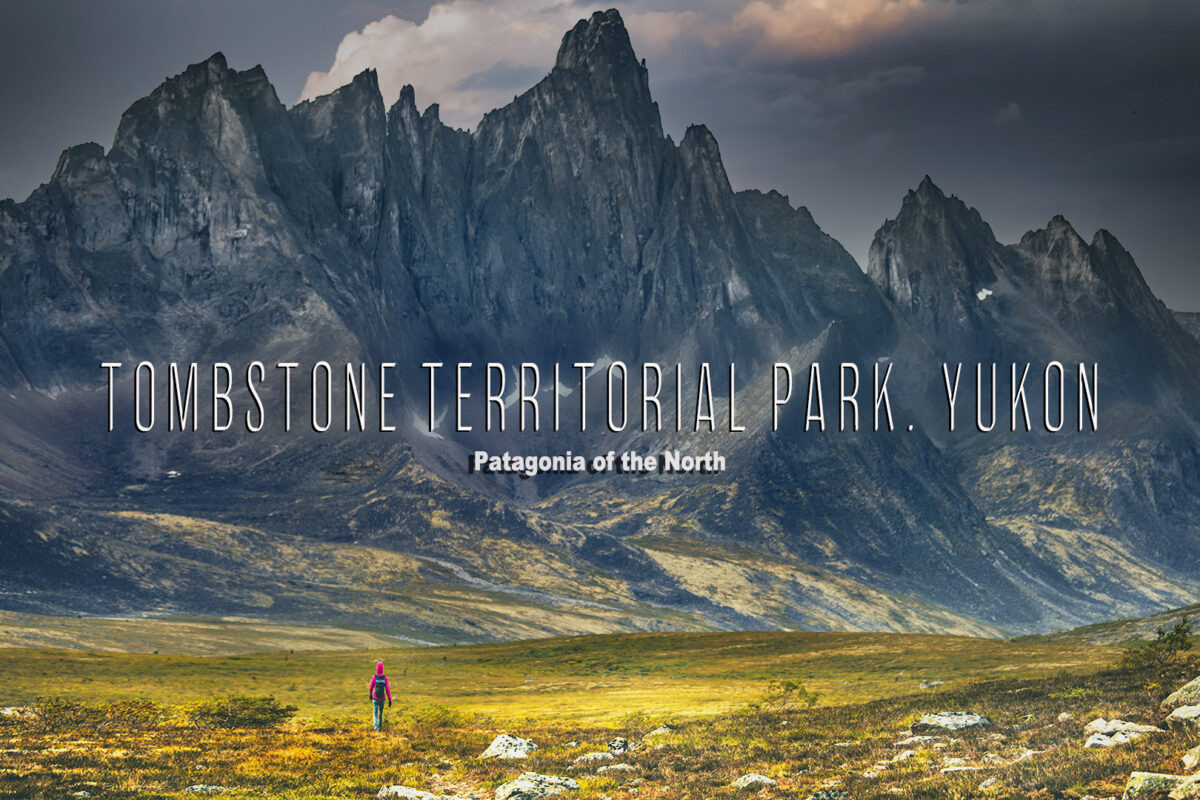
Here is a 25 minute video of our backcountry adventure around Tombstone Territorial Park, YT.
Thank you for watching!
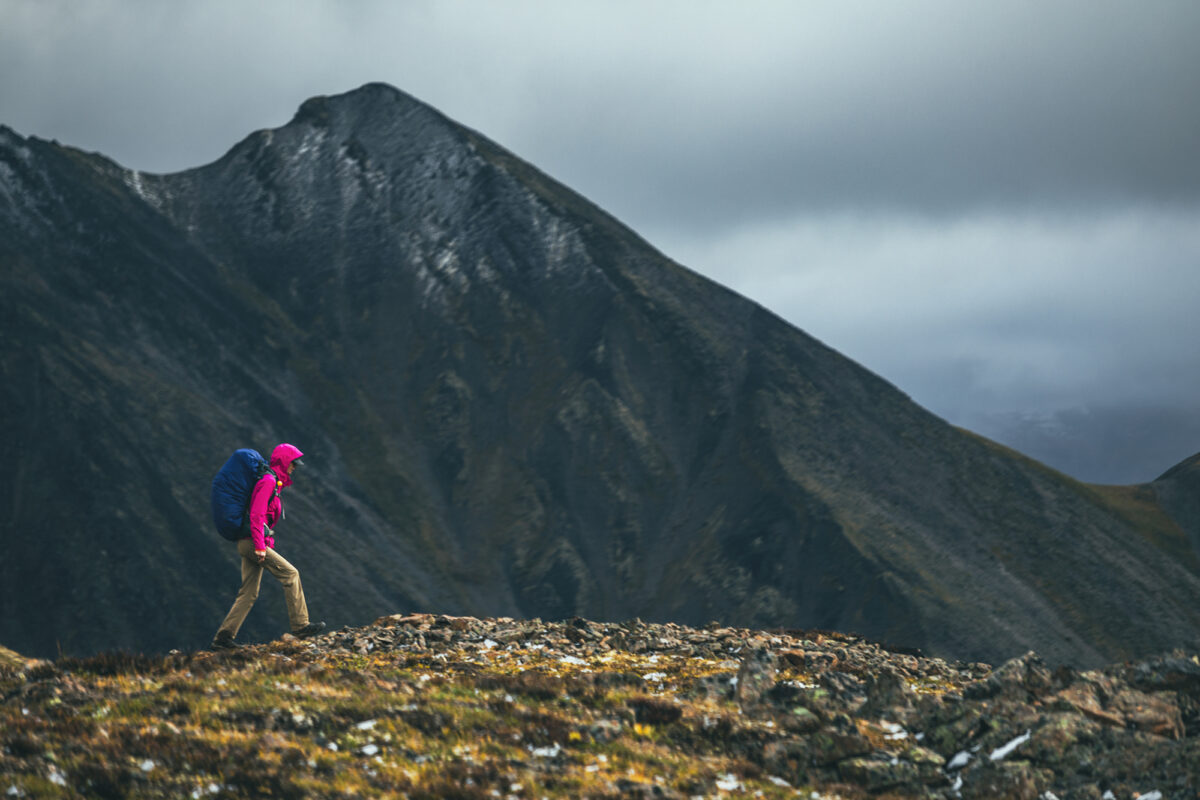
When I had looked at the forecast ahead of starting the trek, I saw that rain was to be expected on this day. The forecast had been very accurate so far, so I definitely prepared myself for a wet day, hiking back over the Divide pass. At breakfast we chatted with a couple who had crossed from Grizzly that morning, hiking the pass before the rain started. They were going all the way to Talus, and taking a snack break at Divide Lake.
It only took us about 4 hours to hike from Grizzly to Divide on day 2, so we really didn’t have to rush out first thing, and decided to take our time in the morning (although we missed the window of no rain, but that would have been quite an early wake up, which we’re admittedly not the best at). Packing up a tent in the rain is a bit of a process, but we took our time and put the tent in a waterproof bag so it wouldn’t get the rest of our stuff wet in the backpack. At breakfast I made sure to eat enough to avoid feeling low energy like the previous day. We had also planned a few energy bars for the way. I knew having a Naakbar just before starting the climb would help a lot.
Once everything was packed up, we headed out in the rain. We covered the first 4km around the mountain pretty quickly, and had our snack at the bottom of the climb as planned. Brice had told me the day before that if I recorded videos with my phone, he could use them, along with his to make short movie about the trek. So I spent a good portion of the climb making little video clips. It ended up being somewhat entertaining and possibly made the way up a bit easier.
Although to be honest I didn’t find it as challenging as I thought it might be, probably thanks to proper fueling + mental prep. We didn’t hang out too much at the top as it was pretty windy, but turns out the rain had pretty much stopped while we were climbing. I think it only picked up after we started going down.
I was slightly more anxious about the way down, as you walk down muddy trail across a grassy area – all made very slippery with rain (hence the name “Glissade” I guess, which more or less means slip-and-slide in French)
I was pretty cautious going down and was hoping that even without poles it wouldn’t be too slip-slidy, and in the end it wasn’t so bad. Once we were down it was less than 1km to get to the campground. In the end it only took is about 3 hours to hike the 6km this way (vs 4 hours on the way in).
It was still raining when we set up, which also made it a process, but eventually our tent was up, pretty much dry on the inside, and we headed to the cooking tents for the “goûter” (afternoon snack). Then another rest time in the tent before going back out for dinner. I would say the trek was definitely worth it even with mixed weather, the main drawback being that we spent our “rest time” tucked away in the tent to stay warm and dry, while with better weather we might have hung out by the lakes more, or explored the area near the campgrounds – unless, on the flip side warmer weather would have meant hordes of mosquitoes which could be equally as deterring from being outside. At dinner we shared a table with a group of hikers from Whitehorse, who were doing the trek for the first time after a couple of unsuccessful attempts in the past due to weather.
As a side note, I was pretty delighted with our dehydrated meals. We had a selection of Backcountry Pantry, AlpineAire and Happy Yak, and all were very tasty (all around 600 or 700 calories per serving). Outside of meals and energy bars, we had also bought some treats like mini Toblerone and almond/cashew nuts. I wish I’d brought tea and a few more treat choices, always welcome especially when fighting the cold, but ultimately a we did fine.
One more night before heading out. I finished the book I had started on the first night: “Split Tooth”, by Inuit author Tanya Tagaq, a mix of auto-biographical, poetic, mystical- filled novel about a young girl in Nunavut. It was a pretty good match for the dramatic, cold setting we were in, and a captivating read, actually hard to put down. Although a book is added weight, I wasn’t sorry I brought it along, especially given the time we spent in the tent, hiding from the rain.
It got pretty cold that night, and we woke up to a dusting of snow on the peaks around us.
We made sure once again to have a good breakfast, including a tasty couscous dehydrated meal (1 portion shared), to get us ready for the 12km hike out.
The tent was wet and our pants were pretty muddy but I still had dry pants, socks and gloves so the day started well. We packed everything and set off for the hike out. When leaving Grizzly lake, there’s a creek crossing that isn’t insignificant. Not deep but rocks are spread out enough that it can be a bit tricky to hop from one to the next. We had gone through it 3 times already without a hitch, but this time, I slipped on a rock and ended up with a leg in the water up to my knee – not ideal in near freezing weather.
Thankfully, my goretex shoes kept most of my foot dry, and somehow, my pants repelled most of the water and my long-johns underneath were quick to dry. I still took a moment to change sock and threw a toe warmer in my shoe to avoid any toes going numb. Sadly my gloves were soaked and I didn’t have another dry pair (I did bring 2 pairs. but the first one was a already wet from the previous day’s hike in the rain. Note to self: next time, bring three pairs). So I resorted to hiking sans gloves, which ended up being fine as the temperature warmed up slightly throughout the day.
We had 12 km to hike back to the parking lot, with the first 7 or 8 a slow incline towards the ridge – We didn’t have much views on the way in on day 1, but the sky was much clearer on the hike out, and we were able to appreciate the views from the ridge, including looking back at Grizzly Lake, which could be seen quite clearly from most of the ridge.
We caught up with Kendra & her mom somewhere along the climb. They were still in good spirit as we said goodbye to them.
The portion on the ridge was quite windy, but warmer than down below so it was a bit tricky to know what layers to keep or remove.
We made couple of stops for snacks and eventually started descending back into the trees. The downhill wasn’t bad, but the last section, relatively flat in the forest, seemed to go on forever, I didn’t remember it being so long but again that was at the very start, on fresh legs.
Finally we made it to the car, all muddy and sweaty from the last section, but pretty pleased to be done. We changed to less muddy clothes and shoes and drove to the visitor center to return the bear cans, then we had to drive the 1.5 hours back to Dawson city.
I was hoping we could find a motel room to spend a night in and have a warm shower. But as we soon found out when we got into town, it was Saturday night and everything was booked. I got a bit annoyed as we’d almost booked a room for that night when we registered for the backcountry trip, but decided against it for some reason I couldn’t remember now.
We drove to a couple of RV parks and landed at the Bonanza Gold Motel and RV park, just outside of town.
Although it wasn’t very glamorous (the tenting area was on gravel near the road), it had showers and laundry. I was still intent on having a night in a bed, and I managed to book a room in the motel for the following night.

Our towels were soaked from drying our gear while in Tombstone, but we were able to rent a couple of towels from the motel office. They were surprisingly nice towels, all warm and fluffy, probably just out of the dryer, and that instantly made me feel way better.
Showers were $1 for 2 minutes. I put in $4 dollars, but 8 min ended up being quite a bit more than I needed. Still it was soooo nice to have a hot shower after 5 days of rain, cold, faint sunshine and more rain.
Once we were all cleaned up we headed to town for dinner. Weirdly, despite all the hotels being full, most restaurants were closed. We came to realize that opening hours in Dawson City were to be taken with a grain of salt, as, in the days and a half that we were there, we came across a few “Sorry we’re closed today” hand-written notes on doors. That night we ended up at the Sourdough lounge, adjacent to the Downtown Hotel, and had post-trek celebratory burgers and fries.
We’d been told that Dawson City had quite the nightlife, but for a Saturday night it seemed pretty tame (although we didn’t venture to the local casino, Diamond Tooth Gertie’s, famous for it’s nightly French Can Can Show). It’s possible the town was still recovering from it’s annual 3-day Discovery Days festival the week before, which apparently is pretty rowdy according to the two of Quebecois guys we’d met while in Tombstone. After dinner we went back to the campground and Brice took advantage of the late daylight to tidy up and reset all the hiking gear, food, etc. while I sat in the tent and finished writing up the tale of our five days of trekking.
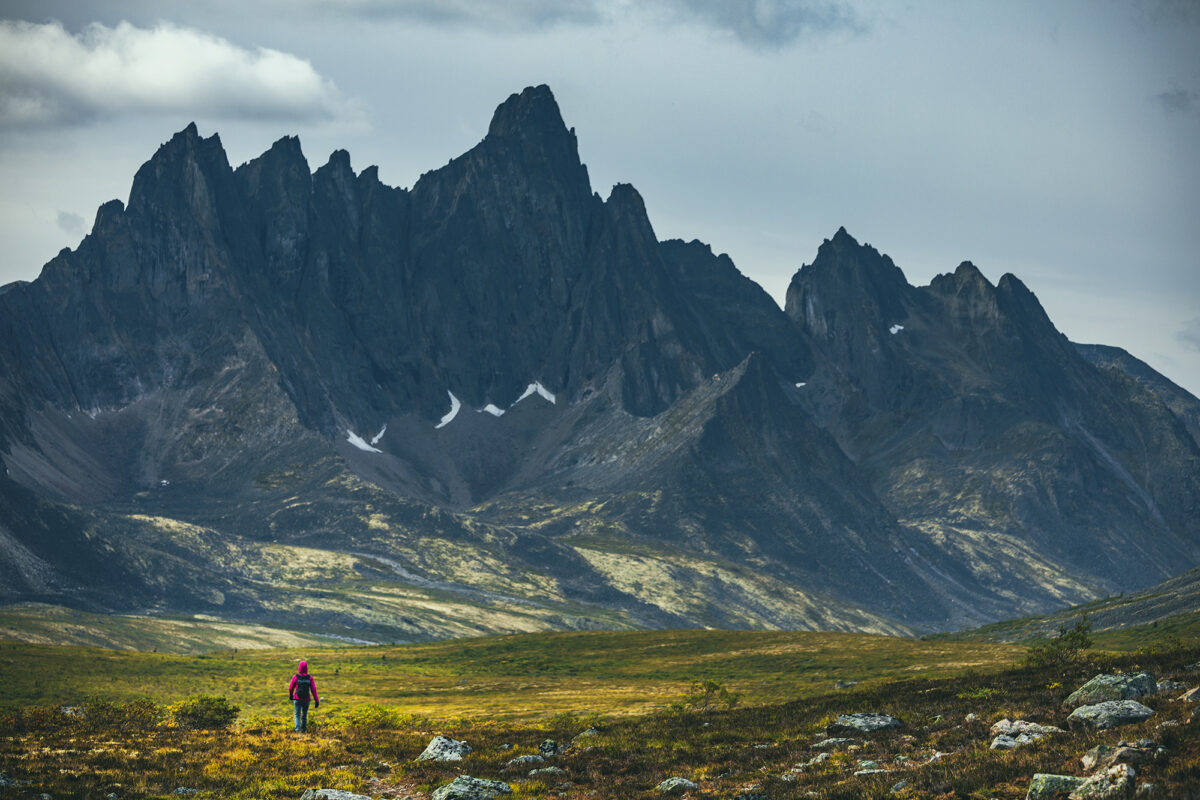
On our third day in Tombstone Territorial Park, we had planned return trip to Talus Lake, from Divide Lake.
As we had already experienced, the weather forecast had been pretty accurate so far, and it didn’t let us down on our third day, when the predicted clear and sunny day turned out to be true. The plan was to hike out to Talus lake and back, for a total of 12km with minimal elevation. There’s a campground at Talus Lake so people do camp there, oftentimes going straight from Grizzly without stopping at Divide for the night. But we liked the idea of having a backpack-free day, and not have to move camp. We chatted with Kendra and her mom again at breakfast. They were taking advantage of the sunny and dry weather to go over the pass and to Grizzly lake. After breakfast we headed out with our light day packs.
After circumventing the lake, the trail climbs very slightly onto a broader plateau, then meanders through the tundra all the way to Talus lake. We realized the range we were looking at from Divide was really the back side of the range overlooking Grizzly lake.
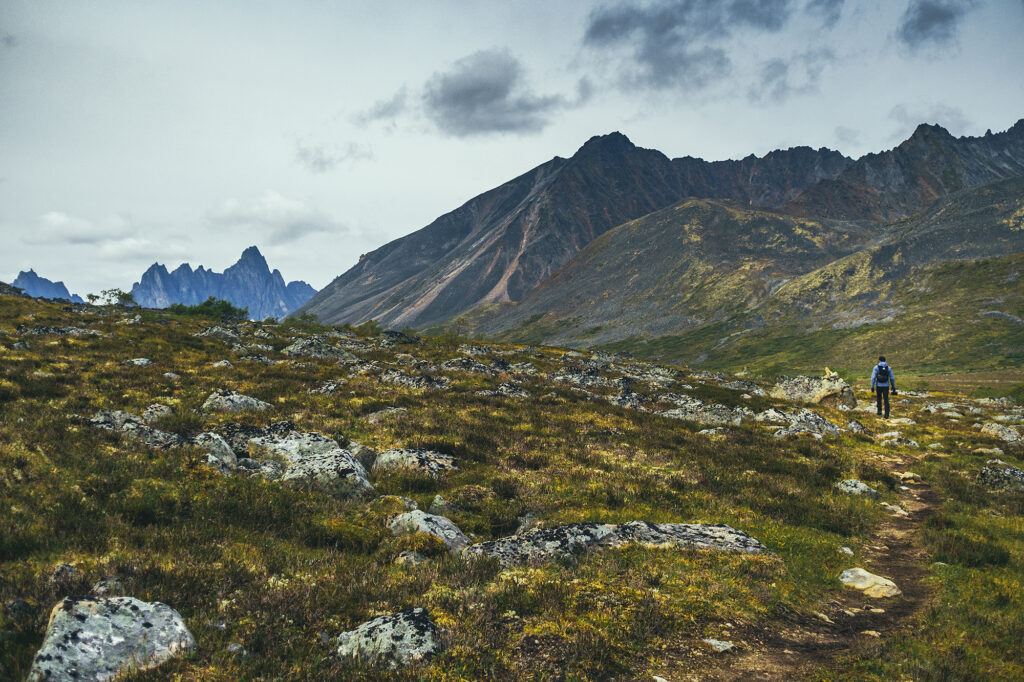

Talus lake was once again very scenic, similar jagged peaks of Tombstone Mountain spreading as a backdrop to the arid, low growing tundra, possibly even more dramatic than the previous two lakes. We had lunch at the lake under the cooking tent. It was sunny but still pretty cold. We had brought a proper dehydrated meal as opposed to only energy bars, as well as coffee to warm up.
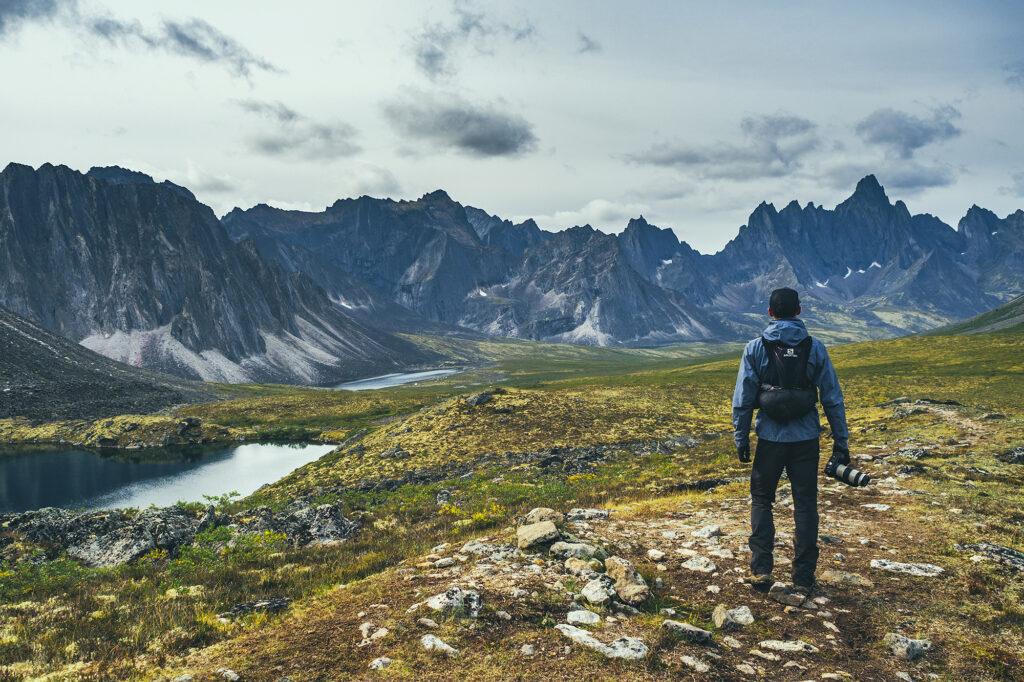
I was actually feeling pretty low energy that day, not sure if it was from insufficient caloric intake, or a result of the previous two hiking days. With the cold, and being quite sensitive to it myself, it did feel like I was burning a lot of calories just to keep warm.

After lunch we explored around the lake a bit then headed back. It was a nice relaxing, easy hike and I was glad we did it pack-free for an easy but still scenic rest day.
That night at dinner we chatted with a couple who had arrived at Divide that day and was planning to do the same thing we did the next day. We also saw a ranger, who had hiked all the way from the start and was pushing to Talus that same day. I guess they’re pretty used to doing the 24km circuit in one go.
It probably wouldn’t be impossible for us either, if we carried a smaller pack and much lighter camping gear.
The ranger asked to check our reservation, which we were both surprised and ultimately glad about – wasn’t expecting a check that far into the route, but at the same time it reaffirmed that we were right to book ahead and properly register.
I’m sure some people might just wing it without a permit, but you then take the chance of not having a proper tent pad (resulting in camping on and damaging delicate ground), or taking one from someone who did pay, which would obviously be very uncool. Ultimately it seemed like Grizzly lake was the busier campground (when we were there anyways), as people may only come for 1 overnight, or decide to turn around and not continue on if the weather isn’t ideal.
The park doesn’t actually allow booking a site at Divide Lake as the first night – you have to book Grizzly Lake before you can book any other sites. This, I imagine is probably due to people in the past underestimating how challenging those 18km actually are to complete in 1 day, and ending up stopping at Grizzly Lake instead, overcrowding that campground as a result.
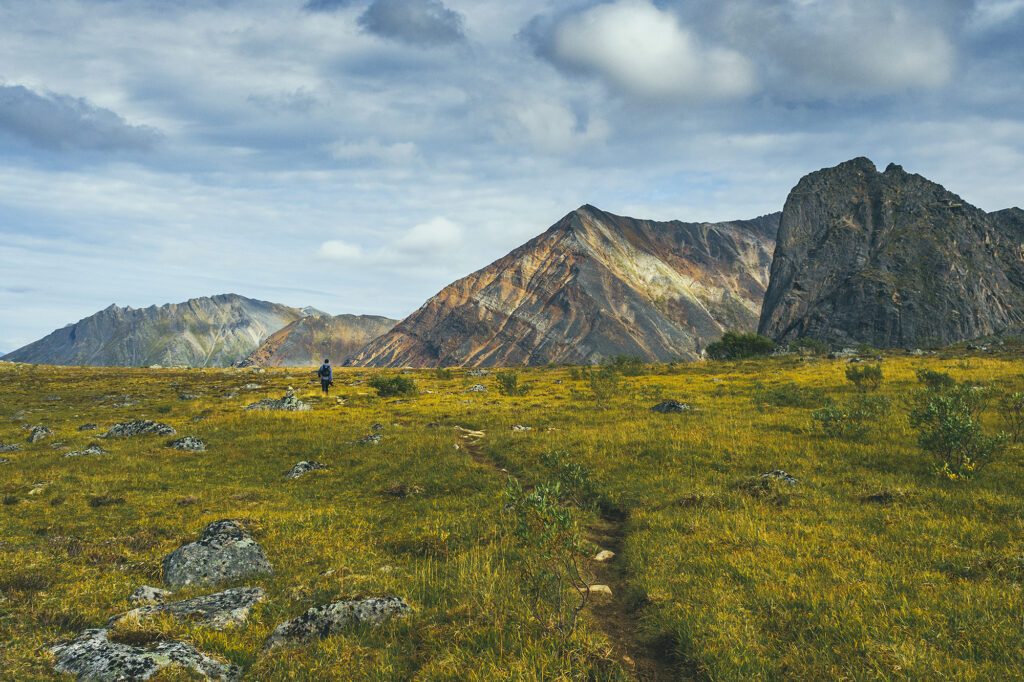
Of course some people would be able to hike in further and bypass the registration system, but that’s at the risk of impacting other hikers and/or the fragile environment. In addition, if you have any problems out there, the park doesn’t take any responsibility to get you out, so it’s best to have your own rescue plan, i.e , leave your trip plan with a friend and ask them to alert the RCMP if you don’t come back when expected.
There is no signal in the park and Satellite is apparently unreliable (we didn’t have an in-reach so we couldn’t confirm).
So bottom line is, despite this being a popular route, there are challenging areas where you might find yourself on your own, so always go out prepared and make sure to communicate your plan in case anything goes wrong.
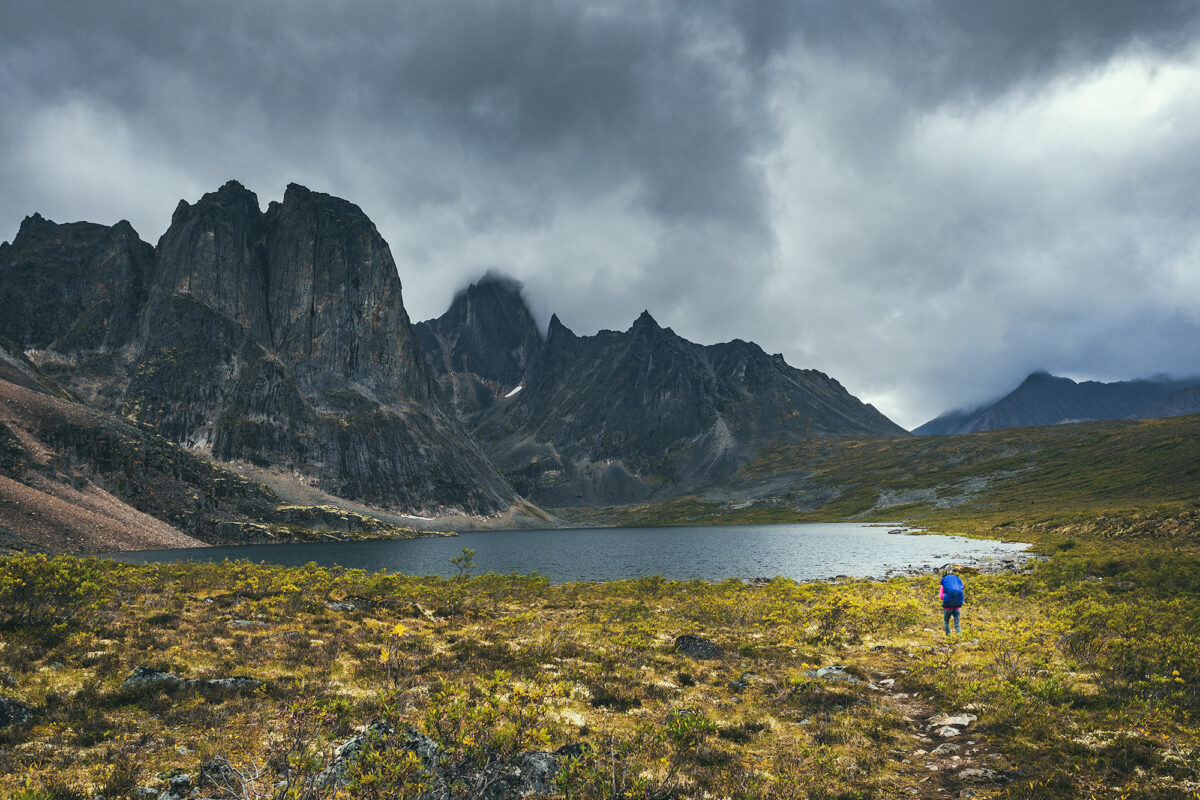
In August of 2021, we drove more than 9000 km from Vancouver, BC to The Yukon and back. One of the highlights of our road trip was a 5-day backcountry trek in Tombstone Territorial Park.
Tombstone territorial Park is a 2200 square kilometre area of protected wilderness, offering stunning views of tundra landscape, incredibly rugged peaks, and home to abundant wildlife. The park lies within the Traditional Territory of the Tr’ondëk Hwëch’in First nation and is a legacy of the Land Claim Agreement. It is managed in collaboration between the territorial government and the Tr’ondëk Hwëch’in First nation, with particular efforts on protection and preservation.
The park offers a wide range of hiking opportunities, including a 48km out-and-back backcountry circuit.
Dawson City
We got to Dawson City a bit after 3pm, and quickly looked for an outdoor gear place, after realizing that our small backpacking stove was out of commission – not ideal since we were about to head off for 5 days in the backcountry.
We found what we needed at the Trading Post, a neat shop that sells modern outdoor gear as well as a bunch of antique ones. It’s one of those stores that make you want to buy everything! I also bought a small sewing kit to fix up a hole in one of my gloves.
After that we headed to the airbnb booked for the right, a good way to comfortably reset and get our backpacking stuff ready for the next 5 days of t hiking and backcountry camping.
One thing we hadn’t quite sorted before arriving were bear canisters. They are required to go into Tombstone, to protect both the wildlife and people. We hadn’t bought or rented any as I had read somewhere that the park could lend us some, for a $60 deposit.
As I did a final check on the park website, I got a bit nervous as about being able to indeed borrow them so I ended up calling the Interpretive Center minutes before it closed at 5pm, and the confirmed that although they no longer rented them, they still had some on hand to lend. The park is quite far from Dawson so I guess they would still prefer people go in with the proper bear safety equipment than go without. There wasn’t really anywhere else to find bear canister in and around Dawson City. I don’t actually think the Trading Post sold them (but maybe they do) and the only possible rental was with the local adventure guides in town, but they wouldn’t open until 10am the next day – too late for us as we were headed to Tombstone at 7:30.
We had already purchased a number of dehydrated meals, so we put them and all other energy bars and snacks in ziploc bags, as was suggested in the park guidelines, to contain food smell as much as possible.
Once we were relatively ready for the next day, we went out to try and find a place to eat. At 9pm on a Monday, the only place we found open was the Drunken Goat and that night they appeared to be making pizza only – which we didn’t mind. It took 45 min to get our food, (we had been warned by the waitress from the get go, but there weren’t many other restaurant options). In the end the pizzas were pretty substantial and we took left overs home with us.
There is a 1.5 hour drive from Dawson City to the Tombstone Interpretive center, which is actually 20km past the trail head for the backcountry circuit. We left around 8am and were there at 9:30am to collect a couple of bear canister in exchange for a cash deposit. In hindsight, although convenient when you show up without them, I would probably acquire bear cans before hand, as the only reason we drove to the center was to pick them up and return them – which also meant we had to be back before 5 pm on our last day, otherwise taking the risk of having to camp at the front country site and return them in the morning.
In any case, by 10am we were at the trail head and we organized all the food into the two cans. They seemed pretty full but we might have been able to squeeze in a few extra snacks, I know I felt like I could have had more food during the 5 days, but of course that would also mean more weight. In the end we did alright with enough trail food, afternoon snacks and a couple extra lunch packs to complement protein and energy bars during the day. We had an assortment of dehydrated meals from several brands, which all turned out to be tasty very (especially so after hiking in the rain!)
The first day involved a 12km hike in to Grizzly lake, with 750m of elevation gain. The first 2.3 km were on a relatively flat single track trail, albeit very muddy and with lots of roots and rocks. Then we left the trees and started climbing to the ridge on exposed terrain, which was probably the most challenging part. It was rainy and windy, with zero visibility and for a moment I thought “what the hell are we doing, is it going to be miserable this way the whole time?”. But then I literally had another moment when I thought “Well, I could be grumpy the whole way, or I could NOT be grumpy the whole way” and just like that my mood changed. We stopped at some point, about 4km in, as we were both feeling the ass-kicking from that climb. and had a Naak bar to boost us up (which, as always, it did).
The trail continued to climb more gradually along the slope, just below the ridge, and eventually we started to descend into the valley. The lower part of the trail wasn’t necessarily easier, it even got a bit more technical with rocky areas to cross at regular interval, and not a lot of smooth ground. Eventually though we made it to the campground, which, on a clear day, can actually be seen from quite a distance.
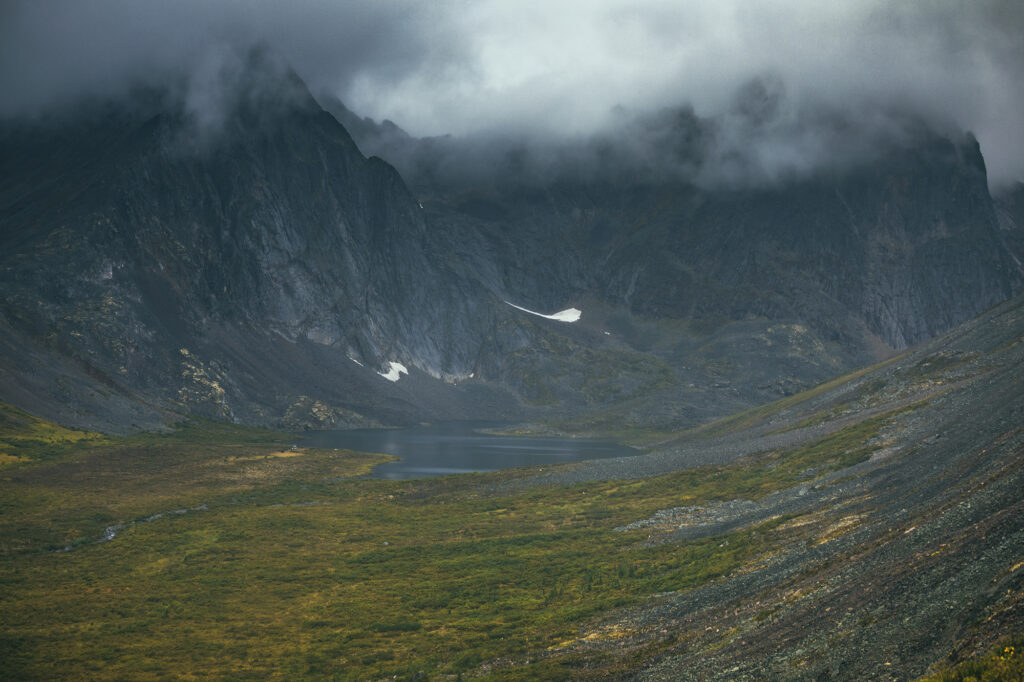
The campground was set up with a dozen or so tent pads along a well defined trail. Setting up a tent anywhere else is prohibited, as the ground is covered in very delicate tundra vegetation, moss and shrubs that take a long time to grow in this harsh environment.
The tent pads are some distance from the lake, and the trail continues down to its shore, passing a couple of outhouses on the way. The cooking tables and tents are set up near the lake, along with bear caches. All food must be prepared there, and stored in the caches, to avoid attracting animals and especially bears, to the sleeping areas.
The cooking tents were pretty convenient shelters from the rain and provided good opportunity to chat with other hikers. We had a snack and got our tent set up. Since the weather was still pretty cold and wet, we tuckered in with a book until dinner time.
At dinner we chatted with two twenty-something guys from Quebec, who were planning on hiking to Talus lakes the next day (passing through Divide lake) to spend the night.
After dinner there wasn’t much to do other than go back to the tent and read for a bit, so we were pretty much in bed by 9pm. It rained overnight, but stopped in the morning.
Second leg of the circuit, we hiked to Divide lake via Glissade Pass. The pass is only about 1km from Grizzly lake, but has an elevation gain of 450 m over 1/2 km. So it’s STEEP! The trail on the Grizzly lake side was a muddy path going through grassy areas and some rock patches. We pretty much put our head down and climbed on, passing hikers returning from the other side, trying not to slip down the muddy trail. This is when I thought to myself that hiking poles might be useful on the way back down, but oh well, let’s focus on getting to the top for now. Eventually we did, and although there were a bit of clouds on the summits we could see clearly the valley on the other side. The trail now descended just as steeply but this time through thick, loose shale, which turned out to be very fun, as the ground was loose enough that you could slide a bit but not so loose that you would lose balance and fall. It only took us 5-10 min to come down.
After that we had another 4km to go to Divide lake, around a slope to the left. Although relatively short, the trail was once again a mixture of technical dirt, rocky, boulder crossings, and we felt pretty happy when we arrived. We found a tent pad, set up camp and went for a snack in the cooking tent.
This time we chatted with Kendra and her mom Edie. We first thought they had hiked in the same way we did but soon found out they had been dropped off by helicopter at Talus lake, the furthest of the three lakes on the circuit, and were now hiking out over 5 days, taking a couple of rest days in the process,
Kendra was in her forties (I’m guessing), and her mom probably close to 70, so we were curious how she would fare on the pass and the hike out, having so far only covered the easiest 6km of the circuit. Kendra was being quite motherly with her own mom, and half-jokingly expressing concerns that she hadn’t been eating all the allotted food, so Kendra had to keep carrying it.
They very generously offered us some desert a couple of tortillas, and later some coffee packets when I thought we were out, all the while thanking us for taking that weight off their pack. They were a pretty amusing pair and we ended up chatting with them on several occasions, as we found them again at Grizzly lake on the same night we came back and hiked out the same day as us.
Weather being on the colder side, we retreated once again to the tent to relax between 5pm and 7pm, then had dinner before going to bed early- definitely earlier than what we had been doing while car camping, staying up by the campfire until 11 or 11:30pm since it was light out so late.
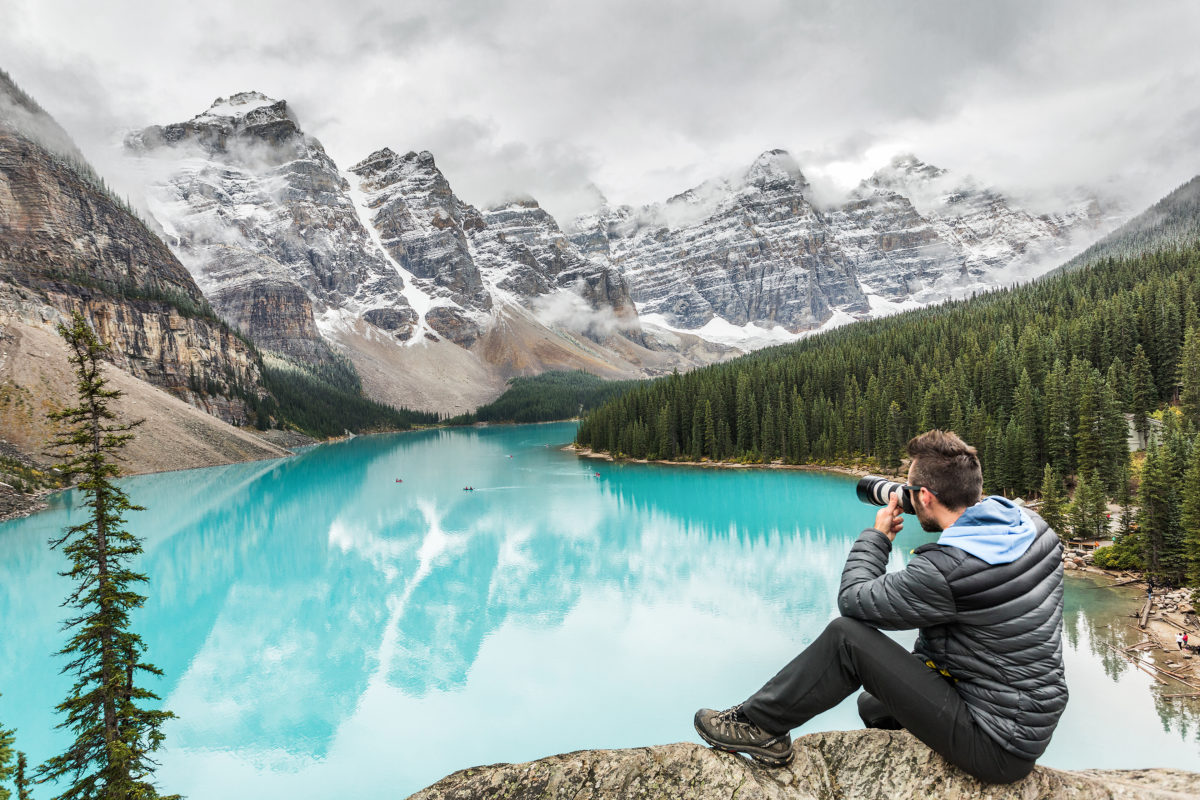
This lake is probably one of the most photographed in Canada (maybe even North America), and I had seen it pop up countless times on my Instagram feed. Similar to the Torres in Patagonia, experiencing it in real life was like stepping into a postcard….a very busy postcard. Every photo on social media shows a single individual sitting or standing peacefully across from 4 rocky giants, separated by turquoise blue water.
What photos don’t show, is the view the 4 giants would be staring at: a parking lot full to the brim with cars and tourist buses. A flow of the aforementioned tourists inundating the shore of the lake, specifically the boulder pile conveniently located at the one end of the lake, offering the perfect vantage point over the water. From the towering distance of those four peaks, that side of the lake would likely resemble an ant nest, little black spots crawling all over the mound and taking turn to pause (and pose) on that one outcrop, that one viewpoint, ready to record their own make-belief moment of piece, quiet, solitude and reflection.
On this cold September morning, the trees were already sprinkled with frost and the temperature at lake level was below zero. It was shoulder season and the volume of visitors had already whittled down to a a somewhat manageable number (especially for us). We even managed to park less than 50 meters from the edge of the lake.
The iconic mountain range was partly obstructed by low clouds and fog when we first arrived, but it slowly cleared out as the morning went by. After joining the other ants on the boulder pile, and taking the inevitable solitary shots, we moved on to the next part of our exploration.
Thanks to the folks at Advanced Elements, we were able to bring 2 inflatable kayaks with us on the trip – an incredible addition to our usual get-up, allowing us to get slightly less mediatized perspective on the Canadian landmark.
Of course, you can rent canoes at Moraine Lake – red and orange ones, contrasting little lady bugs on the teal water. For $90 an hour. Yikes. Steep is a bit of an understatement, but admittedly, leaving the busy shore behind to enjoy the much more authentic tranquility of the water is part of the full experience (there are a limited number of canoes to rent, which ensures that traffic from the shore doesn’t spill over to the lake – although I’d be curious to know how many other floatation devices are brought along on the summer months.)
In just minutes, our bright orange kayaks were ready to go and a beat later, we were paddling away from the hustle. The lake has a surface of about 50 hectares, definitely big enough to put distance between us and the real world, and enjoy a truly serene moment. Floating on completely still lake water, surrounded by mighty mountains, slowly revealing themselves to us as time passes in slow motion. A true moment to stop and let go.
It was lunchtime when we came back to shore. After putting the kayaks away we grabbed a sandwich at the Lodge before heading up one of the many trails that start from the lake.
Another recurring fact learned from the few iconic places we visited. When you step away from the main, off-the-road attraction, 90% of the crowd vanishes. We made our way up the Larch/Paradise valley trail. We climbed the first 4k of switchbacks at a steady pace and arrived in the larch meadow less than an hour after starting.
That mid-september week seemed to be the perfect timing for our trip, as the Larch tress had already started to turn gold, and although frost was already covering the ground, the first snow dump wouldn’t be happening until the following week as we found out later.
We didn’t make it up to Sentinel pass, but the snaking trail up the flank of the mountain was clearly visible from Minnestima Lake where we stopped before turning around. We could see the most adventurous of the little ants climbing up to the ridge and disappearing to the other side. We on the other hand made our way back down to the lake. The sun was starting to set and the clouds add cleared off the peaks and we climbed one more time to the top of the ant farm to capture yet another of the many faces of Moraine Lake – water mow glowing under the sun.
That evening we drove back west toward Yoho national park. We found an available camping site at the Kicking horse campground, the only one of the 4 in Yoho to offer hot showers – a pretty attractive feature when you’re camping by 0 degree weather.

On day 2 of our Canadian Rockies road trip, we headed to the Illecillewaet parking lot, the start of most trailheads in Glacier National Park. The Park is home to black bears and Grizzly, and parties smaller than 4 people are advised not to go on some of the trails that cross the most bear-populated areas.
We decided to hike the Abbott Ridge trail, a short but steep, intermediate-level hike . The first part is mainly single-track switch backs in the forest. 2,6km from the start, we passed Marion Lake, surrounded by dense forest and not very remarkable.
Soon after the lake, at the trail split, we took the shorter but steeper way. The switchbacks continued for a while, but trees slowly gave way to rocky formations, and eventually the trail opened up to a vast alpine meadow with quasi all-around views of the valley and surrounding glaciers. Looking up to the end of the trail, stood the straight rock face of the ridge.
The weather was pretty stable on the way up but we could see black clouds slowly making their way through the valley, and eventually aiming towards where we were. We had lunch at the weather hut then headed back down. It looked like the trail might continue further up, but we weren’t sure how much more, given the straight up wall that stood a few hundred meters from us (after checking online later on, I found out there was indeed a trail that climbed to the top of the ridge).
Still, the view from the meadown was not disappointing, and for a while we watched the clouds dramatically travel through the valley, from Bonner Glacier on the western side, towards the Illecillewaet Neve to the East.
On the way back, we took the longer way down alongside a rocky slope. The two trails reunite about 500 meters before reaching Marion Lake again.
We made it back to the car just as the rain started to pour.

A few week-ends ago, Brice and I went camping at Greendrop lake, near Chiliwack.
Originally, I had my eyes set on Elk Mountain. I had hiked to the top of Elk mountains last summer with my friend Kaitie, and since then had wanted to come back with Brice. A few weeks ago, a photo popped in my instagram feed, of a camping scene located on Elk mountain. I thought this would indeed be a great camping spot. The hike up is only 3,5k and the next day we could hike the additional 7km return to Thurston Mountain before coming back down.
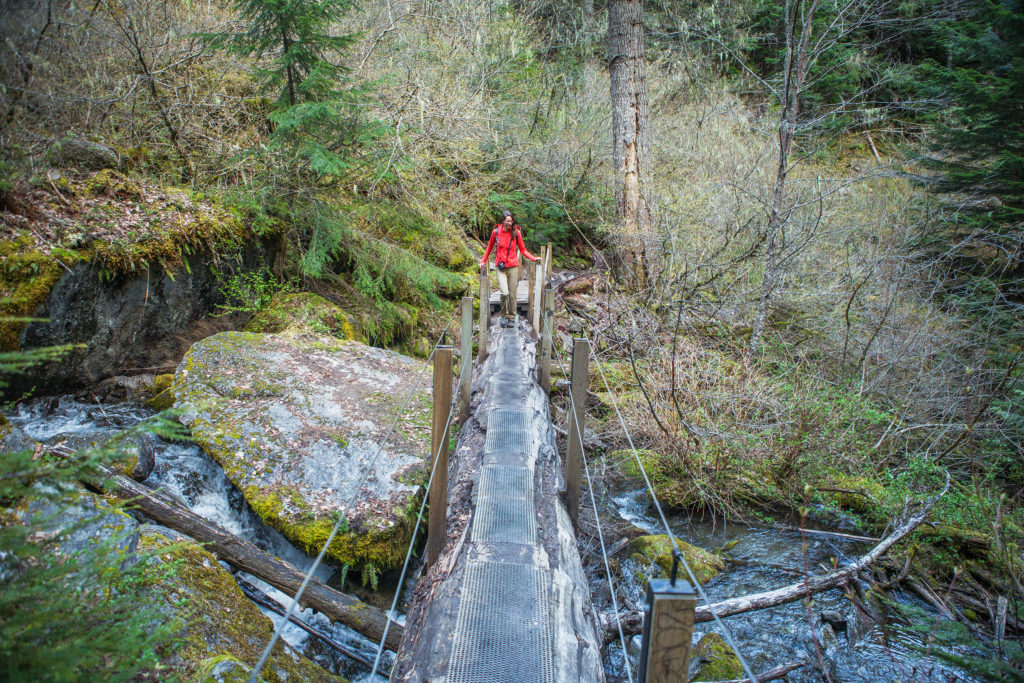
We didn’t leave the city until 3:30pm on Saturday – first we had to go stand in line for two and half hours to go vote for the french elections. It took us a couple of hours to drive to the Elk Mountain trail head, and when we got there, we were welcomed by a nice big sign indicating (amongst other rules) “No Camping”. I was so excited about the idea of camping up there, with the potential of catching a pretty epic sunset and/or sunrise over the valley, I hadn’t thought to check whether it was actually ok or not.
Now, following the rules might make us look a bit square, but if our trip to Patagonia has taught us anything, it is the importance of such rules in the preservation and conservation of the land. And in this case, the sign clearly indicated that the mountain was home to sensitive and fragile eco-systems, which camping (and building fire, etc) would contribute to damaging. Not to mention that leaving our car un-attended over night could potentially create concerns of lost or injured hikers if a forest ranger happened to be driving by…(We’ve hiked up to the mountain since, just for the day, and it seems to be a pretty popular camping spot despite it all, so that second concern might not be a huge deal, but still…)
So with that we improvised a plan B. Reaching for our Backroad mapbook, we decided to head further east to the Lindeman Lake trail head. We had gone to Lindeman last summer, just for an afternoon, but continuing along the same trail past the lake would take us to Greendrop Lake, another more remote camping option.
It was already 6:30pm when we arrived at the trail head, but we figured we had a good two hours of daylight still, so we got going. The hike to Lindeman is only 1,7km, with some steep and technical sections, but overall fairly easy. Once we arrived at Lindeman, we walked along the lake through the camping area. Being the first sunny week-end in quite a while, the grounds were pretty busy with campers. The trail took us along the shore, and through a boulder field at the northern end of the lake, then we left Linderman behind and continued hiking deeper into the back country. We had another 4,2km to cover to get to Greendrop, which ended up taking about 2 hours. The trail was pretty technical, alternating between densely forested area, and rock-covered single track along boulder slopes, with the addition of a few stream crossings, made likely bigger at this time of year by the snow melting.
The last 1.4 km were all in trees, but there was a good foot of snow left still in that portion, which slowed us down a bit. About 700 meters from the campground, we had to take the head lamps out to finish. Thankfully the trail was very well marked with bright orange markers and ribbons every 25 meters.
We made it to the campground around 9:30pm. It was completely dark by then. There were two groups of campers already set up, with nice fires going (they had likely logged their own firewood all the way up, as everything around was way too wet to burn). We hadn’t planned on making any fire, but even with the slightly below zero temperature of the night, we managed to stay cozy in our puffies and sleeping bags.
Dinner was quick to make – the folks at Good to Go had sent us a selection of their dehydrated meals to try, and it turned out to be quite tasty (we had the thai curry that night, and their granola and oatmeal for breakfast the next day).
The next morning we took our time having breakfast and checking out the lake in daylight – it was still mainly covered in snow and ice. Then we headed back down to Lindeman. With the sun out, the trail was really beautiful, shafts of light coming through the trees and creating bright rims around the moss-covered boulders – all in classic PNW fashion.
While we had seen no one on the way up, we passed quite a few people taking the day hike to Greendrop. It took us much less time to arrive back to Lindeman, and we decided to take a break on the northern end of the lake, rather than join the crowds along the western shore. After a quick bite, we walked the remaining few kilometres back along the lake and down to the parking lot. Lindeman is a very popular destination – as we had found out last summer, and no wonder. The turquoise colour of its water, surrounded by snow-capped mountains make it probably one of the most accessible, scenic places in the area.
We reached the parking lot at 2pm, perfect timing to dodge the growing crowds of afternoon hikers. Before heading back to Vancouver, we couldn’t leave Chilliwack without stopping by I Fly for Pie, the diner-style restaurant located at the Chilliwack airport, famous for its decadent pies…

On the 5th day of our trek, our we woke-up to rain – we had been pretty lucky so far with the weather, so it wasn’t surprising that it eventually caught up with us. There was quite a bit of activity in the communal hut, with groups trying to pack their gear away from the rain and preparing themselves for a wet hike. We took our time having breakfast and let the majority of hikers leave ahead of us. There were only 2 more people left in the hut when we finally headed out.
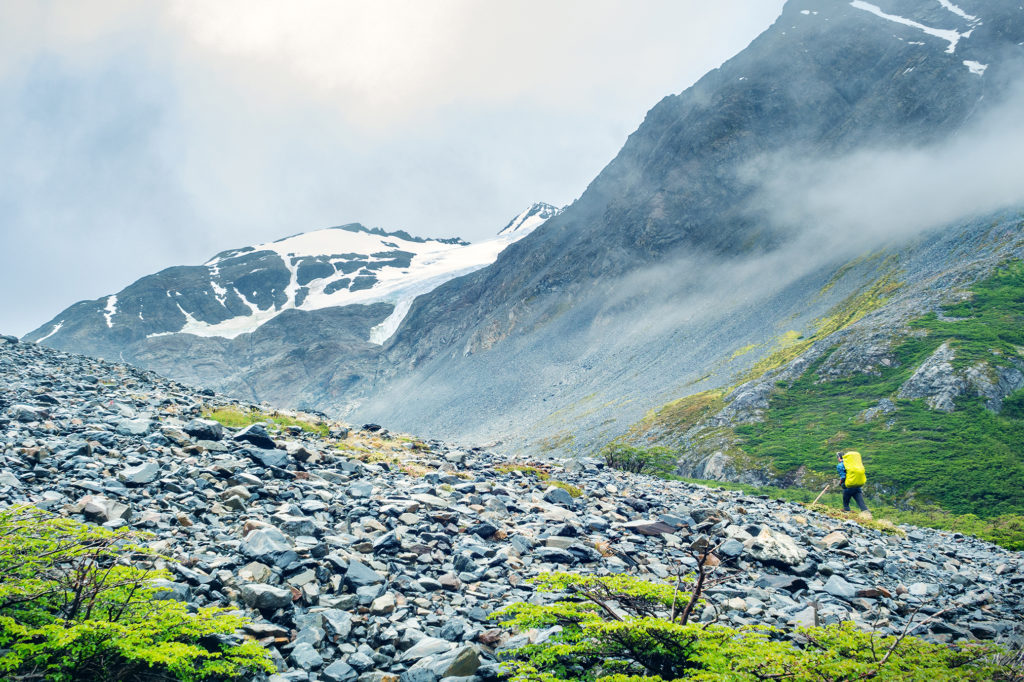
The beginning of the trail what somewhat reminiscent of climbing the Grouse Grind or BCMC in North Vancouver, single track forest trail with roots and rocks and complete with copious amount of mud. The rain had actually almost stopped as soon as we left the camp, so at least we stayed dry.
Eventually we left the tree line and started going up a steep scree. Looking up we could see pretty far to the top of the hill, and I was so glad that we were climbing this on fresh legs and not after 10km, like we would have had to if we had stayed at the Dickson campground.
I actually very much enjoyed the climb. Although we started in the clouds, the sky was slowly clearing up and we could see pretty clearly the mountain range around us as well as below, the valley we had just come from.
We thought that Jen had gotten an early start from Los Perros but turns out she had left after us, and caught up with us on the way to the top, so we finished the climb more or less together.

We had been warned against bad weather and really strong winds when going through the John Gardner pass. If the weather is too bad, rangers will actually close the pass and you’ll have to wait until the next day to cross – there was indeed a ranger stationed on the way to the top who I guess would be there the whole day making sure crossing conditions were good and enforcing a cut off after a certain time of the day. But once again, we lucked-out. As we stepped through the pass, the view on the other side was pretty incredible.
We found ourselves looking down at a sea of clouds, with sun hitting the summits of the mountains marking the edge of the Hielo Sur (the great Southern Ice Shelf), from which Glacier Grey flows down. It was a breath-taking view, of a whole different scale than the iconic “Torres”. And to make it even more exceptional, there wasn’t any wind, not even a breeze. We stayed at the top for a bit, taking in the view and as we did, the clouds below were starting the dissipate, revealing the subtle shades and relief of the glacier.
We then started to descend on the other side. We still had a bit of a ways to go to the Grey campsite, where we were going to spend our last night in the park. After climbing down the scree and moraine, with incredible views of the Glacier all along, we were back in the forest for what turned out to be one of the most challenging sections of the trek, due to the very slippery and muddy trail, and the weight of our bags on a steep downhill. Once again we had planned lunch ahead and cooked noodles at camp that morning to take with us. So when we started to feel low on energy we were able to just stop on the side of the trail and eat.
There was one more campground after the pass and before Gray, Campamento Paso. We didn’t stop there long, as it was already a bit crowded with the hikers from Los Perros who had left before us, and instead just kept moving. The sign at Paso indicated we had 10km to go to Grey campground, which the map said would take about 5 hours (it seemed a bit much on paper, but it did take us close to 4 hours).
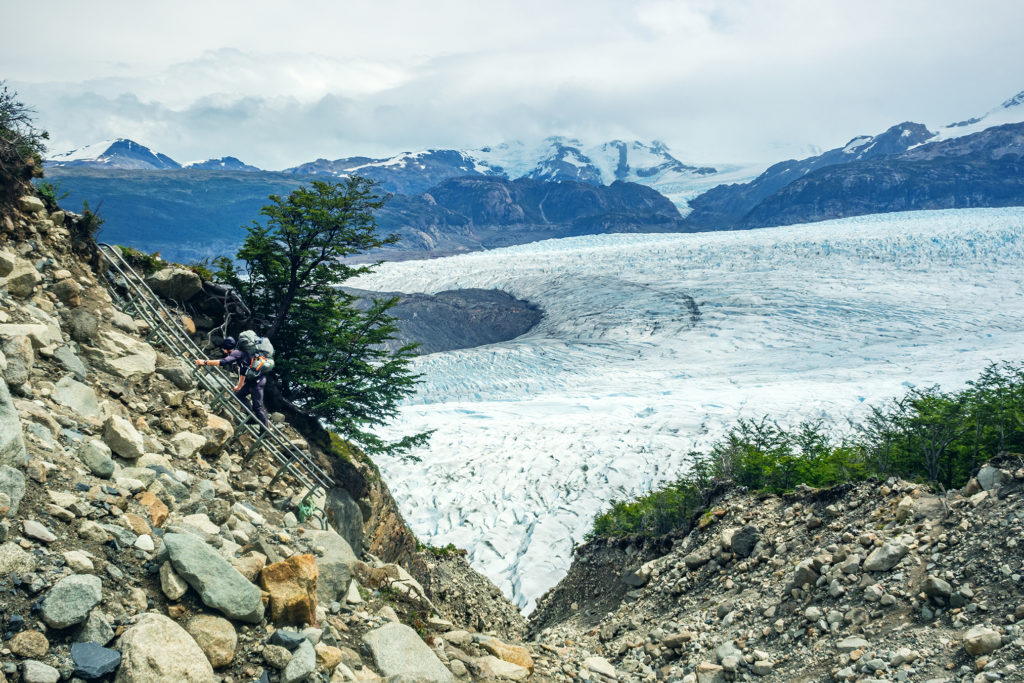
The trail continued to be pretty steep all the way down to Refugio Grey (we were going from 1200 meters to more or less sea level). There were a few cool suspension bridges along the way, and a stream crossing that involved a somewhat sketchy steel ladder anchored to the side of the small canyon.
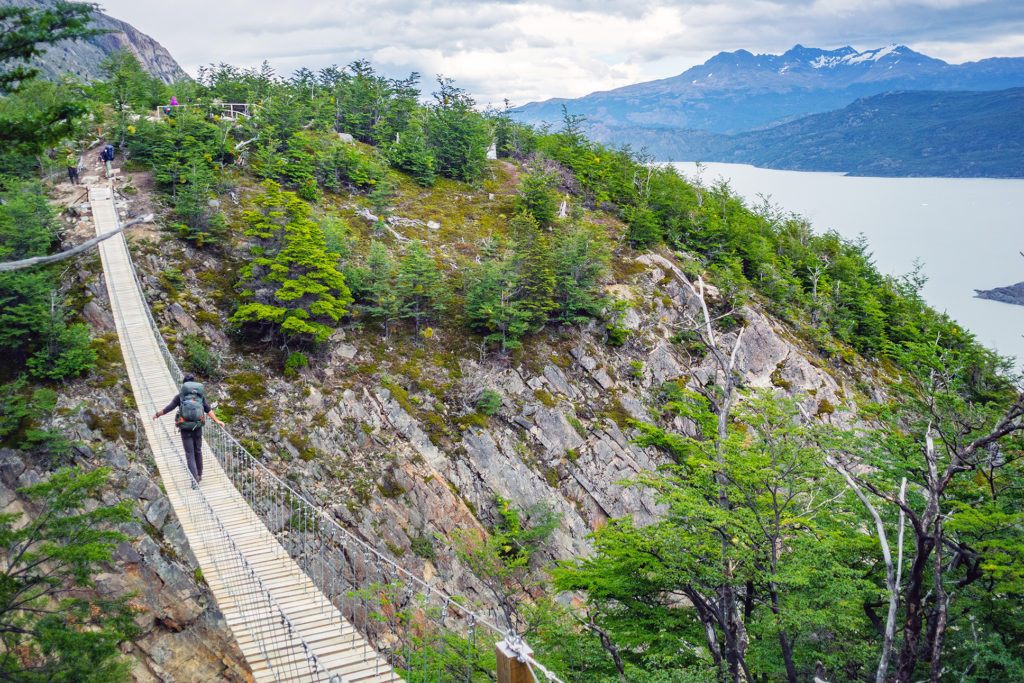
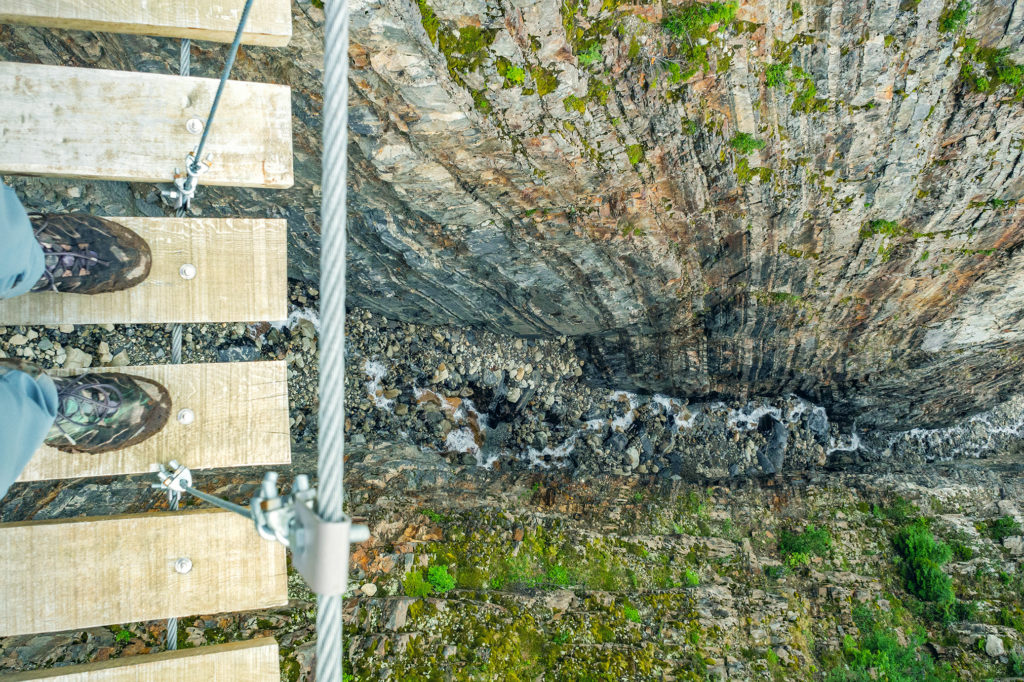

Eventually, the ridge trail took us past the edge of the glacier and along the lake. We had left Los Perros around 8:50am and after 17km we reached Grey campsite just before 5pm. Grey is a pretty big campground, as it hosts hikers finishing the full circuit, as well as “W” hikers coming counter-clockwise from Refugio Paine Grande (where we had gotten off the ferry a few days earlier).
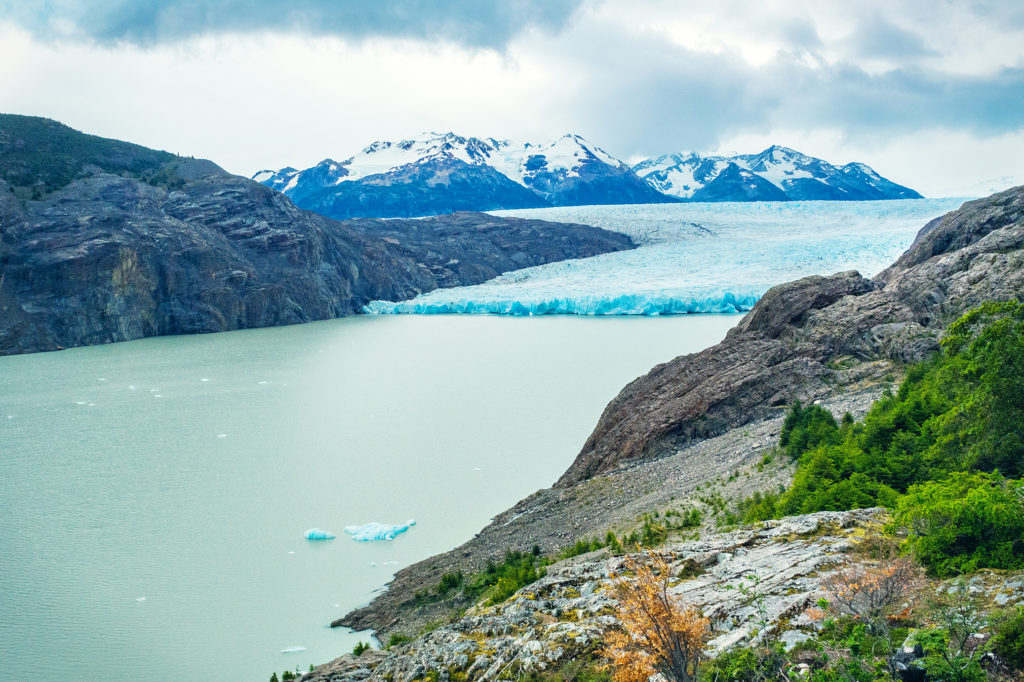

After checking in, we waited for the camp store to open and grabbed pretty much every flavor of our now favorite pound cake, as well as additional snacks to replenish our calories.
The campground advertised that showers would be heated between 7pm and 10pm. I was within the first ones in line at 7pm – which might have been a mistake, because the water was not heated yet when my turn came – unless, and I have a feeling that’s the real reason, “heated” meant warmed up from glacier temperature to room temperature…
The next day was our final day in the park. We had 11km to hike to Paine Grande to catch the ferry around 11:30am, and then the bus back to Puerto Natales. This final stretch offered more views of the lake, with the glacier becoming smaller and smaller behind us.
We had already noticed that signs along the trail were approximate at best when it came to distances, but on that day we came across the most striking example of it. The first sign we reached that morning indicated that we had hiked 6km since Refugio Grey, and had 4 more kilometers to go until Paine Grande. At that point, Brice’s watch actually read 4.8km. 4km later, we reached another sign, which now indicated we had hiked 7.5 km since Grey, and had 3.5 more to go to Paine Grande. Yup, that first sign was pretty much off by about 7km, which is a bit much on a total distance of 11. So bottom line is, signs in Torres are not to be trusted.
We reached Paine Grande, on the shore of Lago Pehoe, at 10:45, with ample time to spare before the ferry arrived.
There is (or there was) an additional section of trail that you can tag onto the the rest of the circuit (which turns it into the “Q” circuit) and continues from Paine Grande to the Administration office. From there you can get on a bus back to Puerto Natales, without having to take the ferry. It seemed like in the past there might have been a campsite halfway along that section, but apparently it was closed between November and March. I had contemplated at some point staying an additional night in the park, and doing the full Q, but since the option of camping on the way to Administration wasn’t available at the time, we decided to stick to our initial plan and return to Puerto Natales that afternoon via the ferry. We did however put our bags down by the ferry dock and with that weight off, literally flew up the hill along that trail to get a higher vantage point on Lago Pehoe and all the Torres behind. The perfect vista to end our 6-day trek.
On the boat ride back, we were able to take in one last time the view of the iconic mountain range, highlighted by the turquoise water of the lake.
Back in Puerto Natales, we headed straight to Yellow Plum, a small campground near the center of town that we had noticed when we came through the first time around. We had been pretty impressed by the smart layout of the place and had decided to try and spend the night there rather than in a hostel, on our way back from Torres. There were 3 other tents in the small camping area. They belonged to an Italian couple, who was biking through Patagonia and had started in Ushuaia, an American who lived and taught English in Brazil and was traveling during the summer school break, and a Chilean family of four. We made each other’s acquaintance around the fire pit and later over diner, that we were able to prepare in the outdoor kitchen. The owner’s family also came for diner and to ring in the new year and at 12am, every one was outside celebrating and hugging each other. I asked Carlos (the owner) what were some of the Chilean traditions on New Year’s eve and he told me that one of them was to take a suitcase or a bag and go around the block, to bring more travel in the new year. That was easy enough for us to do and shortly after 12am, we took a stroll around the block with our (empty) backpacks on.
The next day we left Puerto Natales in the afternoon, and took a bus to Punta Arenas. When we originally booked our flights, Punta Arenas seemed to be the best option near Torres to fly back to Santiago (although it might be possible to fly out of Puerto Natales). When planning the trek in Torres, I had factored in an extra day so that we had a buffer in case we were forced to stay in the park longer, and to avoid the risk of missing our flight back to Santiago (and as a result, Vancouver). Since we didn’t need that extra day in the park, we spent it in Punta Arenas instead. We arrived in the evening on Jan 1st. Our Airbnb host, Miguel, came to pick us up at the airport, and took us on a quick drive around the center of the city.
The next day our flight wasn’t until 5pm, so we spend part of the day walking around town and along the seaside, before heading to the airport. Punta Arenas is located on the straight of Magellan, which connects the Pacific and Atlantic ocean. It was the southern most place we had ever been.

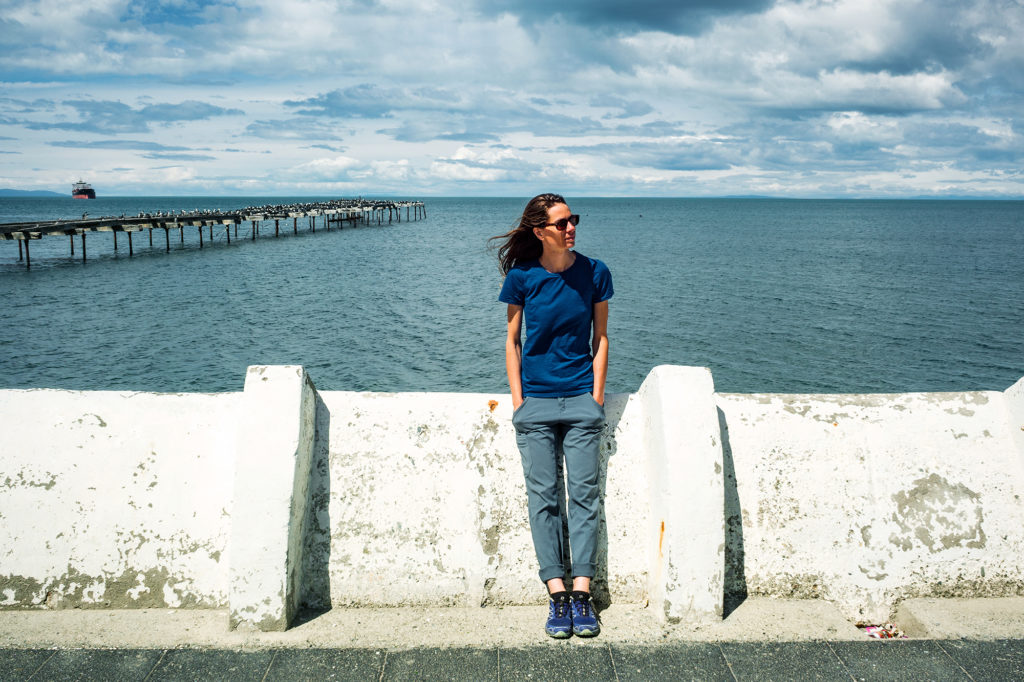
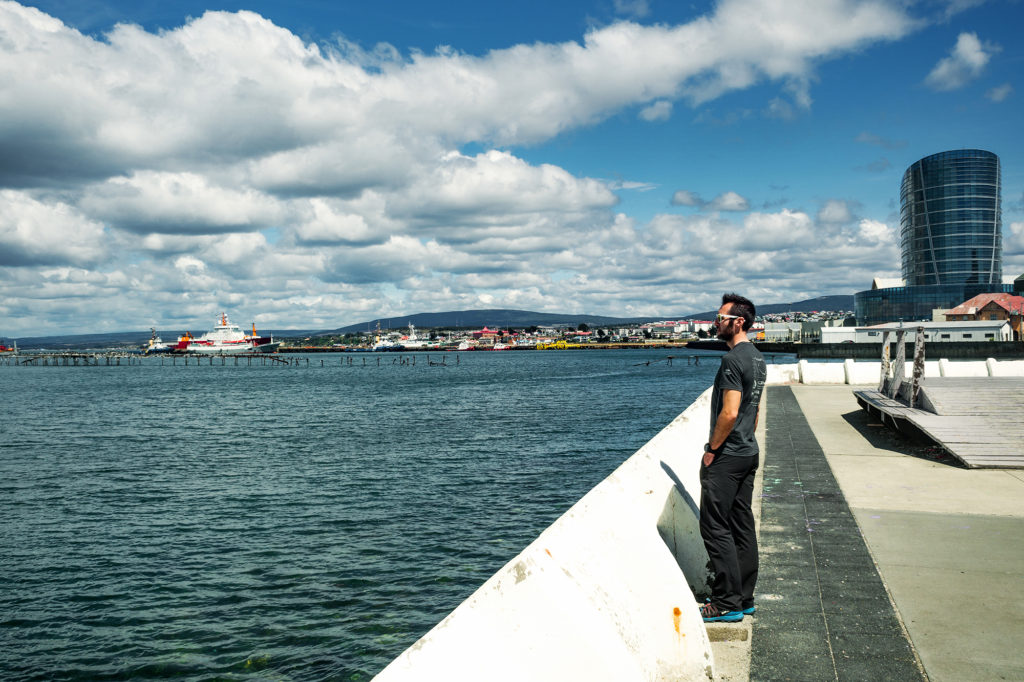
The flight from Punta Arenas to Santiago was about 4 hours. Between Santiago and Vancouver, we had a 12hour lay-over in Mexico city – but at that point we didn’t really feel like immersing ourselves in a city of 20 million people. So instead we headed to the Aero Mexico executive lounge, and for about $25 per person, we were able to spend the day enjoying comfortable couches and unlimited food and beverages, until it was time to board our flight…
And then just like that, it was time to go home…